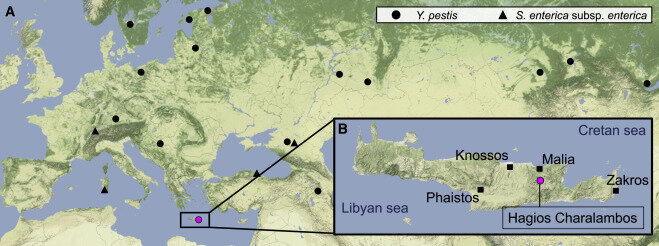Pathogens Detected in Bronze Age Remains in Greece
A team of researchers from the Max Planck Institute for Evolutionary Anthropology, the Max Planck Institute for the Science of Human History, the British School at Athens and Temple University has found evidence of pathogens in the teeth of individuals from the Bronze Age that could explain why two ancient civilizations failed.

In their paper published in the journal Current Biology, the group describes their genetic study of teeth found inside a cave called Hagios Charalambos on the island of Crete.
Prior research has shown that the Old Kingdom of Egypt and the Akkadian Empire, both Bronze Age civilizations, experienced sudden declines in population several thousand years ago.
It has been suggested that climate change and/or other unknown factors led to the decline, which also resulted in damage to infrastructure, reductions in trade and major cultural changes.
In this new effort, the researchers have found evidence suggesting that diseases could have been behind the decline.
The work involved studying the teeth from the remains of people dated back to approximately 2290 and 1909 BCE that had been brought to them from the dig site on Crete.
They found evidence of typical bacteria found in the modern human mouth—the kind that can lead to tooth decay. But more importantly, they also found evidence of Yersinia pestis—the bacteria behind the plague—and Salmonella enterica, which is the bacteria responsible for typhoid fever.
The findings suggest that an epidemic could have been responsible for the population decline in either or both of the Bronze Age civilizations.
The researchers note that there is one caveat—the strain of Yersinia pestis they found was not the same one that devastated so much of Europe centuries later; it has gone extinct, as has the Salmonella enterica strain they found.
Thus, it is not known how transmissible either were, or how deadly. Still, the evidence of such pathogens means that historians must factor in the possibility of disease as a reason for the fall of the two major civilizations.
They suggest further genetic studies be done on other ancient samples to determine how widespread such infections may have been.





